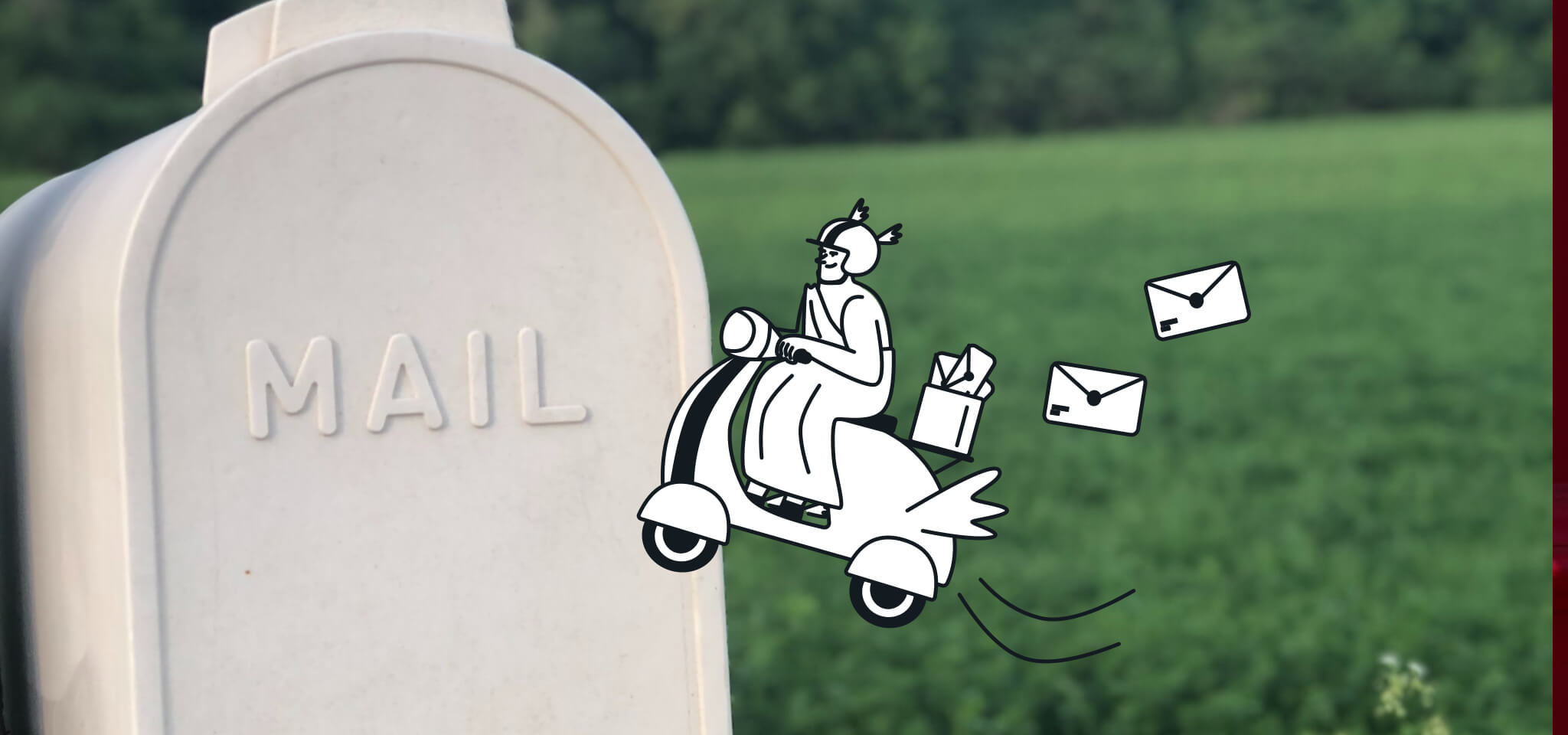Email best practices
Reducing email’s carbon footprint
Even though it’s still one of the cleaner marketing channels, emailing has a carbon footprint. Let’s understand how much energy the emailing industry uses, and how we can reduce it.

PUBLISHED ON
When it comes to protecting our planet, every step toward cleaner practices – small and big – counts. So, what if we told you that emailing, as clean and green as it seems, actually has a carbon footprint?
We recently wrote about green marketing and the environmental impact our marketing activities have. But what about email specifically? What does the carbon footprint of email look like, and is there any way to reduce it?
World Environment Day is just around the corner, and there’s no better time to do an eco-conscious deep dive into the world of email. Let’s explore what contributes to email’s carbon emissions and find ways to help email marketers go green.
Table of contents
The issue with spam
Size matters
Servers and network
Devices
How it works
The challenges
Keep your list clean
Avoid email blasts
Reduce email size
Test your emails
Email’s carbon footprint
So, first things first, where does email’s carbon footprint come from? Well, there are several factors.
Just like any digital channel, emailing relies on energy. In fact, your brands’ website leaves a carbon footprint too. Between hardware production, powering servers 24/7, browsing, and streaming, the tech world uses quite a lot of energy– and that obviously includes email.
For example, research shows data storage and transmission emits 97 million tons of CO2 a year – roughly equivalent to the annual carbon footprint of Sweden and Finland combined. Similarly, the median global water footprint of internet use is estimated to be 2.6 trillion liters of water, or the equivalent of filling over 1 million Olympic-size swimming pools.
But how much of it is linked to emailing? Well, that’s a little harder to calculate. The carbon footprint of an email depends on a lot of different factors. The weight of your email, any attachments included, the device used to open that email, the country it comes from, the recipient’s country, the country where the data is stored... All these elements have an impact on the carbon footprint of an email.
Miker Berner-Lee’s in his book How Bad Are Bananas? The Carbon Footprint of Everythingclaims that a person’s average annual email usage is between 3-40 KGs of CO2 – the equivalent to driving 10-128 miles in a small petrol car. He also goes on to break down the individual emissions of different types of emails:
CO2 emissions | Email |
|---|---|
CO2 emissions | |
0.03g | Spam email picked up by your email filters |
Email | |
0.2g | Short email sent between smartphones |
0.3g | Short email sent between laptops |
17g | Long email that takes 10 minutes to write and 3 minutes to read, sent between laptops |
26g | An email that takes you 10 minutes to write, sent to 100 people, 99 of whom take 3 seconds to realize they should ignore it and one of whom reads it |
This can seem like a lot, especially if we consider how many emails are sent daily but sending and storing emails represents only 0.2% of the global carbon footprint of the digital industries. One hour of video streaming, for example, generates 400 g of CO2e – crazy if we consider 700,000 hours of video are consumed every minute globally.
All in all, email is a relatively green marketing channel already, but that doesn’t mean we can’t or shouldn’t do better.
What are the main reasons behind email’s carbon footprint?
Millions of emails get sent daily, all of which produce CO2. So, what parts of emailing consume the most energy, and what can be done to reduce its environmental impact?
The issue with spam
One of the top concerns when it comes to email’s environmental impact is spam. After all, unsolicited emails don’t just bother people, they also waste energy. Sending them, receiving them, and even unknowingly storing them uses energy. Plus, there are a lot of them – imagine how much energy is literally being wasted by spammers worldwide.
Fortunately, spam filters help reduce the amount of CO2e linked to these unrequested messages to around 0.3 g by detecting and eventually removing all of this junk mail, ensuring these unwanted emails aren’t stored in your inbox forever.
Size matters
When thinking about the carbon footprint of an individual email, the first thing that comes to mind is the weight of the email itself. The more megabytes, the more electricity you’ll need to power it through the Internet pipes. But old figures that said that a 1 MB email was responsible for 35 to 50 g of CO2e have since then been revised –it’s now closer to 3.5 g per 1 MB email, as we saw earlier.
That doesn’t mean we shouldn’t care, though. The weight of your emails still matters, especially if you consider how many of these extra-large emails you’re sending. Reducing your volume will always be better.
Servers and network
So, if it’s not the size of the emails themselves that’s responsible for most of the emissions, the carbon footprint should come from the servers, right? From SMTP and DNS to the multitude of routers that an email has to go through, powering all these facilities certainly has an impact on the environment. And let’s not forget about storage. All of these consume energy.
But contrary to popular belief, servers are not the main energy expenditure when it comes to emailing. It’s even one of the less environmentally impactful, if you consider that most of the large server providers in the world – like Google –are now focusing on ensuring their data centers are carbon-free, powering them with wind or solar power.
Devices
Yes, you probably guessed it by now – the main source of carbon emissions linked to emailing is the production of the devices used to send and read emails. Being responsible when using and buying your devices might be the best way to reduce the carbon footprint of your email usage.
Email Expiration Date: Reducing email’s environmental impact through innovation
All things considered, email is already doing a pretty good job in terms of eco-consciousness. But it can always do better. And that’s where the Email Expiration Date initiative (EED) comes in.
The idea is pretty simple: to enable email senders to set an expiration date on the emails they send, so that these emails get automatically removed from the inbox once they become irrelevant.This will happen either because the sale or offer is over, or because the content of the email is no longer valuable.
Although several email experts had been thinking about this possibility for around 15 years, it only became a reality recently, thanks to emailing and CRM agency Badsender. The EED Initiative strives to bring mailboxes, ESPs, and brands together so email expiration dates can become a reality.
How it works
From a technical standpoint, implementing this solution should be quite easy, especially since most of the elements are already developed. Jonathan Loriaux, CEO and Founder of Badsender, explains:
“We can set an expiration date in the header of the email. Logic has it that the sender should set this date, sending this piece of information to the webmails and ISPs through their ESP’s campaign builder or when developing the email. Then, the webmail parses and executes the information.”
Jonathan Loriaux, CEO and Founder of Badsender
So, what type of emails should include an expiration date? Well, promotional campaigns and flash offers seem like the obvious answer, due to their relevance. But there are other types of emails, like order confirmations or invoices, that might be valuable to the recipient for a very long period. “We’re not setting anything in stone yet,” says Jonathan Loriaux. “So far, we’re only giving guidelines on how EED could be used.”
There are still some unanswered questions about the implementation of email expiration dates – mostly linked to its compliance with regulations like GDPR. Some French webmail providers are currently testing out methods by which mailboxes can get rid of obsolete messages automatically, and we should see the first implementations by the end of 2022.
The challenges
Still, there are a few roadblocks before email expiration dates become the norm. While the technical aspects seem easier to navigate, having to get buy-in from all the different actors in the email industry, one by one, is certainly slowing down the implementation of this initiative.
The different views on climate change �– particularly between European countries and North America – is also another concern. For some big players that profit from selling server space to users, the Email Expiration Date initiative is also a threat to their economic model.
“Considering the current climate crisis, the economic model should take actions that might not be economically relevant. We need to move forward, all of us involved in emailing. Webmails and ESPs are starting to understand this message, because of the open-source culture that’s still present among developers. But for some brands, it’s sometimes difficult to hear that not all the messages they send are relevant and that they should be able to automatically expire. Working as a group, with each entity taking over its share of the work (developing, testing, evangelizing...) will make the initiative go further.”
Jonathan Loriaux, CEO and Founder of Badsender
How to become a more sustainable email marketer
Considering all the sources of CO2e emissions in email can be overwhelming. And while email expiration dates are promising, it might still take a while to see them become the norm.
So, what can you do right now as an individual email marketer?
Well, if you’re following best practices, you’re already on the right track. And if you’re not, here are a few impactful steps to implement – they'll help both the planet and your email strategy!
Keep your list clean
Just like anything related to our industry, environmentally friendly emailing starts with a clean list of contacts. A clean list means you're sending messages to recipients interested in your content – and allowing them to unsubscribe easily if needed – so you are not wasting energy with messages people won’t read. Remove blocks, bounces, unsubscribes, and spam complaints after every email you send, and regularly verify your email list to keep it clean.
Avoid email blasts
Bulk campaigns that are not adequately targeted to your audience aren’t just a bad marketing practice, they’re also a waste of energy. Using segmentation to tailor your messages to different people in your contact list will reduce the number of emails you send, help you target your customers and prospects better, and be less hurtful to the planet.
Reduce email size
Next step should be to reduce the size of your emails. That means reducing the size of any images or attachments included in your campaigns to make them lighter, which will consume less energy when sending and storing them.
Test your emails
Have you ever had to send a follow-up “Oops” email to your contact list after blasting a campaign with a broken link or an embarrassing typo? All those extra emails consume energy and emit CO2e. Avoid having to send those “Oops” campaigns by properly testing your emails before sending them by using an email pre-deployment tool like Email on Acid.
The ball is in our court
Yes, email is a pretty green communication channel compared to most, but it can always do better. While paying attention to our sending habits and how we engage with recipients will help us reduce the environmental impact of the emails we send, we need innovative ideas that will make long-lasting change possible.
That’s why Sinch Mailjet, Sinch Mailgun, and Sinch Email on Acid are proud to support the Email Expiration Date initiative. We only have one planet, and we need everyone’s help to save it. So, if you’re interested in taking part in the EED initiative, check out their website and join here.







